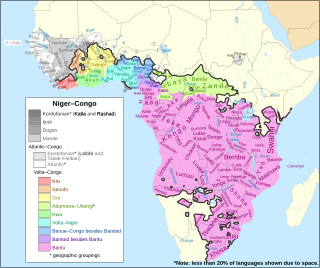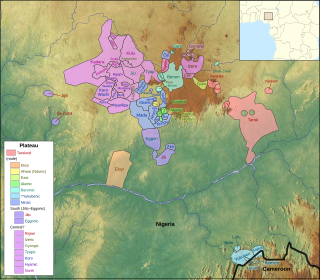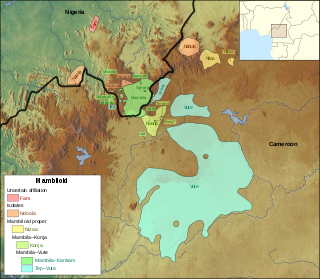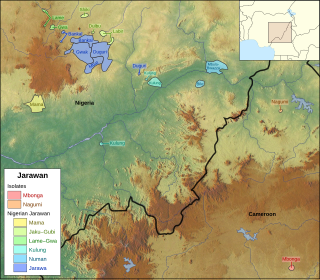
Niger–Congo is a hypothetical language family spoken over the majority of sub-Saharan Africa. It unites the Mande languages, the Atlantic-Congo languages, and possibly several smaller groups of languages that are difficult to classify. If valid, Niger-Congo would be the world's largest in terms of member languages, the third-largest in terms of speakers, and Africa's largest in terms of geographical area. It is generally considered to be the world's largest language family in terms of the number of distinct languages, just ahead of Austronesian, although this is complicated by the ambiguity about what constitutes a distinct language; the number of named Niger–Congo languages listed by Ethnologue is 1,540.

Benue–Congo is a major branch of the Volta-Congo languages which covers most of Sub-Saharan Africa.
The Adamawa languages are a putative family of 80–90 languages scattered across the Adamawa Plateau in Central Africa, in northern Cameroon, north-western Central African Republic, southern Chad, and eastern Nigeria, spoken altogether by only one and a half million people. Joseph Greenberg classified them as one branch of the Adamawa–Ubangi family of Niger–Congo languages. They are among the least studied languages in Africa, and include many endangered languages; by far the largest is Mumuye, with 400,000 speakers. A couple of unclassified languages—notably Laal and Jalaa—are found along the fringes of the Adamawa area.

Volta–Congo is a major branch of the Atlantic–Congo family. It includes all the Niger-Congo languages and subfamilies except the families of the erstwhile Atlantic and Kordofanian branches, Mande, Dogon, and Ijo. It thus only differs from Atlantic–Congo in that it excludes the Atlantic languages and, in some conceptions, Kru and Senufo.

Southern Bantoid is a branch of the Bantoid language family. It consists of the Bantu languages along with several small branches and isolates of eastern Nigeria and west-central Cameroon. Since the Bantu languages are spoken across most of Sub-Saharan Africa, Southern Bantoid comprises 643 languages as counted by Ethnologue, though many of these are mutually intelligible.

Bantoid is a major branch of the Benue–Congo language family. It consists of the Northern Bantoid languages and the Southern Bantoid languages, a division which also includes the Bantu languages that constitute the overwhelming majority and after which Bantoid is named.

The forty or so Plateau languages are a tentative group of Benue–Congo languages spoken by 15 million people on the Jos Plateau, Southern Kaduna, Nasarawa State and in adjacent areas in central Nigeria.

There are over 525 native languages spoken in Nigeria. The official language and most widely spoken lingua franca is English, which was the language of Colonial Nigeria. Nigerian Pidgin – an English-based creole – is spoken by 30 million people in Nigeria.

The Ekoid languages are a dialect cluster of Southern Bantoid languages spoken principally in southeastern Nigeria and in adjacent regions of Cameroon. They have long been associated with the Bantu languages, without their status being precisely defined. Crabb (1969) remains the major monograph on these languages, although regrettably, Part II, which was to contain grammatical analyses, was never published. Crabb also reviews the literature on Ekoid up to the date of publication.
The Savannas languages, also known as Gur–Adamawa or Adamawa–Gur, is a branch of the Niger–Congo languages that includes Greenberg's Gur and Adamawa–Ubangui families.

The twelve Mambiloid languages are languages spoken by the Mambila and related peoples mostly in eastern Nigeria and in Cameroon. In Nigeria the largest group is Mambila. In Cameroon the largest group is Vute.
Ukaan is a poorly described Niger–Congo language or dialect cluster of uncertain affiliation. Roger Blench suspects, based on wordlists, that it might be closest to the (East) Benue–Congo languages. Blench (2012) states that "noun-classes and concord make it look Benue-Congo, but evidence is weak."

Jarawan is a group of languages spoken mostly in Bauchi State, Nigeria, with some also scattered in Plateau State, Taraba State, and Adamawa State in the same country. Two related languages formerly spoken in Cameroon are now extinct but are believed to have belonged to the group. This connection between Nigerian and Cameroonian Jarawan is attributed to Thomas (1925). Whether Jarawan languages are best classified alongside other Bantu languages or among non-Bantu Bantoid languages is a matter of ongoing debate. A number of descriptions and classifications in the early 20th century suggest that they be may historically related to Bantu languages but not necessarily Bantu themselves. Other perspectives based on lexicostatistic modeling and other phylogenetic techniques for language comparison argue instead that Jarawan languages are properly classified alongside Zone A Bantu languages (A31-A40-A60). For classifications based on these more recent studies, see for example Blench (2006), Piron (1997), and Grollemund (2012).

The Bendi languages are a small group of languages spoken in Cross River State, southeastern Nigeria. Bokyi is one of the Bendi languages having some speakers in Cameroon. Once counted among the Cross River languages, they may be a branch of Southern Bantoid, with observed similarities especially with the Ekoid languages.
Daka is one of two languages spoken by the Chamba people in Nigeria, the other being Chamba Leko.
Gaa, or Tiba, is a poorly documented language of Nigeria. It is apparently one of the Dakoid languages.
Dong, or Donga, is a poorly documented language in Nigeria. Though clearly Niger–Congo, it is difficult to classify; British linguist Roger Blench proposes that it is one of the Dakoid languages, the closest to Gaa.

The Hausa–Gwandara languages of the Afro-Asiatic family are spoken principally in Niger and Nigeria. They include Gwandara and Hausa, the most populous Chadic language and a major language of West Africa.
Taram is language of Nigeria. It has traditionally been considered a dialect of Daka, but appears to be more divergent than that. It is poorly documented, only attested in a publication from 1931.
Northern Bantoid is a branch of the Bantoid languages. It consists of the Mambiloid, Dakoid, and Tikar languages of eastern Nigeria and west-central Cameroon.












